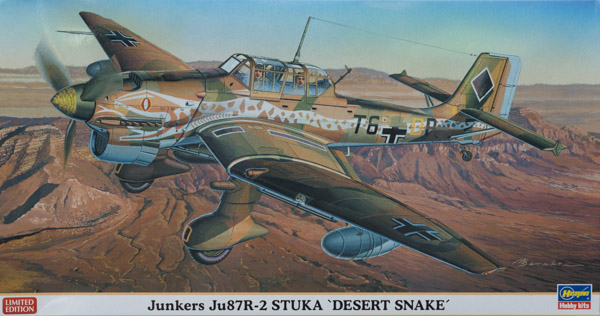
Hasegawa 1/48 Junkers Ju 87R-2 Stuka "Desert Snake" Limited Edition
By Ken Murphy
Overview
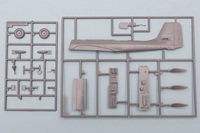 The Stuka is without a doubt one of the most iconic aircraft of WWII, if not all time. As such, this infamous aircraft does not need much of an introduction. The instruction sheet gives a good basic summation of its history, though only a couple sentences about this particular R-2 version. So here's a bit more. The R stood for "Reichweite" or range which explains its out-of-sequence letter designation. The R was simply a long-range version of the Ju 87B (the R-2 including some features of the C). The extended range was achieved with an additional fuel transfer system and additional fuel tanks in the outer wings, as well as the bomb attachment points on the outer wings modified to carry 300-liter fuel tanks. This more than doubled the range 600km to 1,530km. The "Richard" first became operational in April 1940 off Norway and subsequently proved very successful in the anti-shipping role in the Mediterranean area in the spring and summer of 1941.
The Stuka is without a doubt one of the most iconic aircraft of WWII, if not all time. As such, this infamous aircraft does not need much of an introduction. The instruction sheet gives a good basic summation of its history, though only a couple sentences about this particular R-2 version. So here's a bit more. The R stood for "Reichweite" or range which explains its out-of-sequence letter designation. The R was simply a long-range version of the Ju 87B (the R-2 including some features of the C). The extended range was achieved with an additional fuel transfer system and additional fuel tanks in the outer wings, as well as the bomb attachment points on the outer wings modified to carry 300-liter fuel tanks. This more than doubled the range 600km to 1,530km. The "Richard" first became operational in April 1940 off Norway and subsequently proved very successful in the anti-shipping role in the Mediterranean area in the spring and summer of 1941.
The Kit
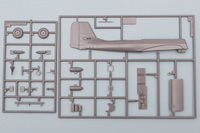 On opening the box, you will find twelve sprues of typical Hasegawa light gray plastic comprising 118 parts. The parts are engineered in such a way as to provide the basis of a variety of Stuka variants, so eleven parts are unused. For this version, sprue G includes the parts for the long-range fuel tanks of the R version. The one clear sprue includes seven parts: four pieces of the canopy plus the cockpit floor window, bomb/gun site and landing light glazing. The framing for the canopies is very subtle – to the point that I had to run my fingernail across the surface to see what side was engraved, but I had to be careful as they must be as thin as it is possible to make clear plastic. The panel lines and surface details of the rest of the parts is also very fine, so much so that I'm going to be a little concerned about them getting buried in paint. The parts themselves are smooth, nicely detailed and free of defects or sink marks, though there is a small amount of flash especially on the wings and flaps. Overall, I'd say they are the kind of quality we have come to expect from Hasegawa.
On opening the box, you will find twelve sprues of typical Hasegawa light gray plastic comprising 118 parts. The parts are engineered in such a way as to provide the basis of a variety of Stuka variants, so eleven parts are unused. For this version, sprue G includes the parts for the long-range fuel tanks of the R version. The one clear sprue includes seven parts: four pieces of the canopy plus the cockpit floor window, bomb/gun site and landing light glazing. The framing for the canopies is very subtle – to the point that I had to run my fingernail across the surface to see what side was engraved, but I had to be careful as they must be as thin as it is possible to make clear plastic. The panel lines and surface details of the rest of the parts is also very fine, so much so that I'm going to be a little concerned about them getting buried in paint. The parts themselves are smooth, nicely detailed and free of defects or sink marks, though there is a small amount of flash especially on the wings and flaps. Overall, I'd say they are the kind of quality we have come to expect from Hasegawa.
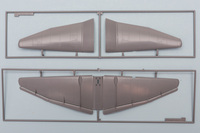 The 8-page black and white double fold instruction sheet includes the history mentioned above, 3 pages diagramming 15 assembly steps and 2 pages of illustrations for painting and decaling. The exploded views of each step are free of excess verbiage, which leaves it up to your imagination or your research to determine what these parts are, however the illustrations are clear and easy to follow.
The 8-page black and white double fold instruction sheet includes the history mentioned above, 3 pages diagramming 15 assembly steps and 2 pages of illustrations for painting and decaling. The exploded views of each step are free of excess verbiage, which leaves it up to your imagination or your research to determine what these parts are, however the illustrations are clear and easy to follow.
Dry fitting the fuselage and wings showed good fit, but when I put the two together it was obvious that the wing root would be a problem. Not a giant one, but it will take some fussing. About that wing: the lower half is one piece which eliminates the problem of correct wing dihedral – a particular problem with an inverted gull wing, but in their effort to simplify wing construction Hasegawa also made the decision to mold the flaps to the lower wing. On the real bird of course, these are attached with a series of rather delicate hinges and rods, but in the kit they are represented with comparatively thick triangles of solid plastic. This does simplify the build and ensure proper spacing and angles, but is far from realistic, which means if you suffer from AMS (Advanced Modelers Syndrome), you will have to make the effort to detach the flaps, shave off the attachments and replace them with photo etch or wire or something.
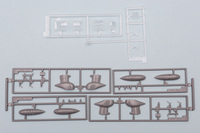 The cockpit interior has a decent amount of detail. The side walls are provided as separate parts and are nicely detailed, but where they fit in the fuselage has been crudely scratched out looking like something I might do if I were installing a resin interior. Was that a mistake, afterthought or recycling of an old fuselage mold? I have no idea. Here again, if you suffer from AMS, you might consider replacing the whole thing with what I hear is the excellent Aires resin kit of the cockpit and engine (Kit #4801).
The cockpit interior has a decent amount of detail. The side walls are provided as separate parts and are nicely detailed, but where they fit in the fuselage has been crudely scratched out looking like something I might do if I were installing a resin interior. Was that a mistake, afterthought or recycling of an old fuselage mold? I have no idea. Here again, if you suffer from AMS, you might consider replacing the whole thing with what I hear is the excellent Aires resin kit of the cockpit and engine (Kit #4801).
The rest of the build looks like it should be fairly simple, quick and trouble free.
Marking and Painting
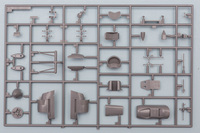 Hasegawa Limited Edition kits generally feature new, special edition decals, and that is the case with this boxing. The decals provide markings for 2 birds: 6./StG2 of Lt Hubert Pölz, Libya 1941, the subject of the boxtop, and 5./StG2 (T6+AN) also Libya, 1941. The decals are sharp, colorful, detailed and in register, the only concern being that the carrier film is a bit thick.
Hasegawa Limited Edition kits generally feature new, special edition decals, and that is the case with this boxing. The decals provide markings for 2 birds: 6./StG2 of Lt Hubert Pölz, Libya 1941, the subject of the boxtop, and 5./StG2 (T6+AN) also Libya, 1941. The decals are sharp, colorful, detailed and in register, the only concern being that the carrier film is a bit thick.
That is all the information the instructions give about the subject of this "Limited Edition's" featured aircraft. It would be nice to know something more about the pilot than simply name, rank and serial number and more about the plane than that it had a really cool paint job. So here's a brief summary of what I could find on Wikipedia:
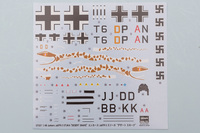 "Hubert Pölz joined the Luftwaffe in 1938. He served on most of the German theatres of operations, taking part the Polish Campaign, French Campaign, Battle of Britain, Siege of Malta and North African Campaign. On 24 June 1941 he sank HMS Auckland off Tobruk. In May 1942 he took command of 6 Staffel. He later took part in the fighting on the Eastern Front. By the end of the war he was commanding I./Schlachtgeschwader 151."
"Hubert Pölz joined the Luftwaffe in 1938. He served on most of the German theatres of operations, taking part the Polish Campaign, French Campaign, Battle of Britain, Siege of Malta and North African Campaign. On 24 June 1941 he sank HMS Auckland off Tobruk. In May 1942 he took command of 6 Staffel. He later took part in the fighting on the Eastern Front. By the end of the war he was commanding I./Schlachtgeschwader 151."
He had quite a career, but to me the most amazing thing is that he survived the war!
As for his plane, it was in Libya, during the North African Campaign that it acquired the snake motif depicted in this kit. Trying to find out more about that lead me down some very confusing and contradictory paths. As far as I could discover, there are only two photographically documented snake Stukas: T6+DP and T6+AN. As mentioned above, the kit has decals for both, but doesn't include the slightly different snake (they were hand painted after all) for AN. In fact, the painting instructions show AN without the snake at all. Strange. There are no known photos showing any other Stukas in snake markings. However, I was able to find snake scheme illustrations depicting a T6+CP and T6+MP as well as DP and AN. They also depict the snake as white with red markings whereas the kit decals are white with sand yellow markings. Hasegawa's markings seem to be based on photos clearly depicting T6+DP.
Translating colors from a black and white image is always a dicey issue, so I will defer to Hasegawa's research. One more interesting point: In photos of the aircraft, under the left wing, you can clearly see a "J" next to the cross. It's certainly not the fuselage code. Could it be the factory code? The decal sheet includes a pair of "Js" as well as Ds, Bs and Ks. The instructions give no indication of where these markings go, but in the fine print at the bottom it states: "Decals without placement instructions may be used freely." I guess they just expect you to do your own research and come to your own conclusions. No doubt much easier than trying to explain all this!
In the end I guess you can do – and defend – whatever you want. If you want to go with the white and red snake, you could use the decals from the Revell kit or go aftermarket with the Tally Ho set for T6+CP.
Conclusion
Hasegawa has been turning out Stuka kits at the rate of nearly one a year since 1994, including a whole array of Bs, Cs, Ds, Gs and now an R. They've had a long time to get this subject down and I think this kit is an excellent example of the results. The moldings are clean, the detail sharp and the decals excellent. The simple basic construction should make this a relatively easy out-of-the-box build, and the killer paint scheme will make it a standout on the shelf. I highly recommend it!
My thanks to Hasegawa USA for the review copy.
